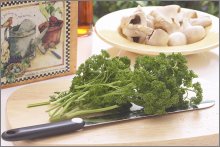The Amazing Health Benefits of Parsley, or, "Hey, I Shouldn't Be Just a Table Garnish!"
by www.SixWise.com
Parsley is an easy-to-use, incredibly flavorful, nutrition
powerhouse, yet, unfortunately, it often gets regarded as
a "throw-away" garnish on dinner plates. Derived
from the Greek word meaning "rock celery" (because
it's related to celery), parsley has been cultivated for 2,000
years, and was used medicinally long before that.
|

Just two tablespoons of parsley provide over 150% of
the daily recommended value of vitamin K.
|
In fact, in ancient times parsley was regarded as sacred
and was used to decorate tombs. It's believed that the ancient
Romans were the first ones to begin popularizing parsley as
a garnish.
Among its more than 30 varieties, the two most popular are
flat-leaf parsley and curly-leaf parsley, both of which can
be found in most supermarkets (and are simple to grow yourself).
Aside from adding a burst of fresh flavor to soups, vegetables,
meats and a host of other dishes, parsley is full of valuable
nutrients that have proven health benefits.
Parsley's Many Health-Giving Properties
Parsley contains three times as much vitamin C as oranges,
and twice as much iron as spinach. It's an excellent source
of vitamin K, vitamin A and folate, as well. But parsley's
nutrition advantages do not end there.
For a quick look at parley's major nutrients (based on two
tablespoons, which has only 2.7 calories!), check out the
chart below, then keep reading to find out about more of parsley's
healthy benefits.
| Nutrient |
Amount |
% Daily Value |
Rating* |
| Vitamin K |
123.00 mcg |
153.8 |
Excellent |
| Vitamin C |
9.97 mg |
16.6 |
Excellent |
| Vitamin A |
631.80 IU |
12.6 |
Excellent |
| Folate (folic acid) |
11.40 mcg |
2.9 |
Good |
| Iron |
0.46 mg |
2.6 |
Good |
* Based on nutrient density and daily value.
Fights cancer. Parsley contains volatile oils that
have been found to inhibit tumor formation in animal studies,
particularly those in the lungs. The oils are not only cancer-fighting,
they're also known to neutralize carcinogens including those
found in cigarette smoke and charcoal grill smoke. Parsley
also contains folic acid, which has been found to help prevent
colon and cervical cancers.
Antioxidant-rich. Parsley contains beneficial antioxidant
compounds called flavonoids. These compounds combine with
oxygen-containing molecules and help prevent oxygen-based
damage to cells. Parsley extracts have also been found
to increase the antioxidant capacity of the blood in animal
studies.
Good for the heart. The folic acid in parsley is a
critical nutrient in cardiovascular health. Specifically,
folic acid helps convert potentially dangerous homocysteine
into harmless molecules, a process that protects blood vessels
and reduces the risk of heart attack and stroke.
Protects against rheumatoid arthritis. A study published
in the Annals of the Rheumatic Diseases found that people
who ate the least amount of vitamin-C-rich foods (like parsley)
had a three times greater chance of developing rheumatoid
arthritis than those who ate the most.
|

For an easy way to get more nutrients in your diet,
make parsley a featured part of your meal -- not just
a garnish.
|
How to Use Parsley
As you can see from the chart above, it only takes two tablespoons
of parsley to yield a host of health benefits (but you can
use as much as you like!). Fresh parsley is always more flavorful
than the dried variety, so if you can get it, always use fresh.
Generally, the flat version tends to have a more intense flavor
than the curly-leaf variety, but pick the type that appeals
to you the most.
Simply wash the parsley, chop it up and sprinkle it into
your favorite dishes, from soups and salads to fish and meat
dishes. Or, check out the tasty recipe below for a parsley
sauce that works great on lamb, fish and chicken.
Garlic, Lemon & Parsley Dressing
Ingredients:
- 6 cloves garlic, finely chopped or pressed
- 6 tbsp. finely chopped fresh parsley
- 6 tbsp. fresh breadcrumbs
- 6 tbsp. softened butter
- Juice of 1 lemon
- Salt & freshly ground black pepper
Method:
- Make a smooth paste of the garlic, parsley, breadcrumbs,
butter and lemon juice
- Season to taste with salt and pepper.
- Spread the sauce on the desired entrée near the
end of the cooking time (in the last hour for meat) and
return to oven.
Source: MountainValleyGrowers.com
Recommended Reading
Disease-Fighting
Plants: 7 Delicious Herbs that Pack a Powerful Antimicrobial
Punch
The
6 Healthiest Staple Foods in Greek Cuisine
Sources
The
World's Healthiest Foods